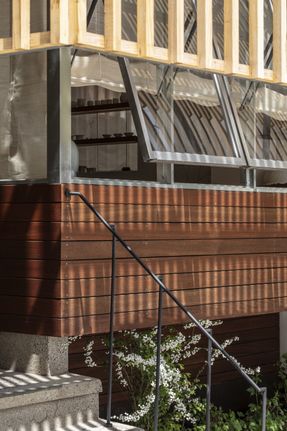ARCHITECTS
Stay Architects
LEAD ARCHITECTS
Junghee Hong, Justin Ko
LANDSCAPE ARCHITECTURE
Botanical Studio Sam
DESIGN TEAM
Pansu Kim, O.do Kim, Moongyem Kim
LOCATION
Seoul, South Korea
CATEGORY
Services, Retail Interiors
Text description provided by the architects.
The Kosomi Studio is a house where the artist lived with her family, and each space inside and outside the building has been converted into a new space while retaining memories of the past.
The most important point was to symbolize change and a new beginning without making too many changes to the house filled with memories.
In particular, when viewed from the front street, it forms a sentimental landscape with the adjacent single-family house, so we did not want to damage the surrounding context.
In order to preserve the scale and emotion of the street as much as possible, the façade structure was made of wood rather than modern materials, and the volume was applied to the right side of the building opposite the adjacent single-family house.
The double wooden skin serves as a screen that controls the south-facing sunlight of the first-floor tea room while ensuring the privacy of the second-floor studio.
The first-floor showroom was planned as an open space with only the minimum walls necessary for spatial division. Each area is divided into a tea room, a living room, and two exhibition spaces with different concepts.
The finishing materials of the showroom were carefully selected to harmonize with the artwork. The main space from the main entrance to the living room is constructed with granite in a wide Korean style and finished with fumigated wood with a prominent texture and spray paint.
Fabrics woven and produced by the artist on a loom are installed throughout the space to amplify the oriental feel of the space. Some walls and ceilings exposed without finishing materials show the building's old exterior along with its history and structure.
The second-floor studio is a raw space. All the walls are exposed here, and traces of the gable roof that has undergone several constructions remain.
The old, collapsed wooden floor frame was reinforced and recast, and finished with high-strength tiles suitable for work.
The studio is largely composed of a molding room, a dyeing room, and a sewing room, and the molding room was planned as a greenhouse-type space suitable for drying and molding paper and fabric.
The interior space is constructed with traditional Korean paper and granite, as well as works woven and produced by the artist on a loom, to amplify the oriental feel, and combines the exposed structure and traces of the existing building, such as the wooden stairs, to weave a new space.
These efforts not only reveal the history of the conversion by showing the original appearance of the building, but also help maintain the village landscape.























